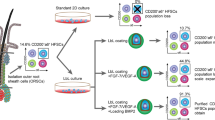Abstract
The field of hair follicle regeneration is advancing rapidly, and there have been a number of major achievements over the last decade. Nonetheless, most of the current technologies are still unable to maintain their in vivo characteristics in vitro. The formation of new hair follicles for the treatment of alopecia using tissue engineering technology is promising; however, little or no work has been attempted in this area so far. In order to enhance the hair inducing ability of epithelial cells and to form the functional epithelial structure, we attempted to fabricate three-dimensional scaffolds by using bladder submucosal membrane (BSM), keratin, hyaluronic acid (HA), and mouse newborn epithelial skin scaffold (NESS). We characterized their properties with respect to the formation of the epithelial structure. The BSM sponge demonstrated the intrinsic activation of melanocytes once we inserted the inductive dermal papilla sphere. We found that the fiber sheet made of keratin enhanced cell spreading and adhesion better than the sheet with HA. The human outer root sheath keratinocytes formed a cluster on the NESS. These scaffolds would be used for the follicular epithelial cell physiology and study for property of them in vitro. This study demonstrated the potential of epithelial cell scaffolds for effective hair regeneration.
Similar content being viewed by others
References
JG Barber, AM Handorf, TJ Allee, et al., Braided nanofibrous scaffold for tendon and ligament tissue engineering, Tissue Eng Part A, (2011).
T Chlapanidas, S Farago, F Mingotto, et al., Regenerated silk fibroin scaffold and infrapatellar adipose stromal vascular fraction as feeder-layer: a new product for cartilage advanced therapy, Tissue Eng Part A, 17, 1725 (2011).
SJ Hollister, WL Murphy, Scaffold translation: barriers between concept and clinic, Tissue Eng Part B Rev, 17, 459 (2011).
V Greco, T Chen, M Rendl, et al., A two-step mechanism for stem cell activation during hair regeneration, Cell Stem Cell, 4, 155 (2009).
VA Botchkarev, R Paus, Molecular biology of hair morphogenesis: development and cycling, J Exp Zool B Mol Dev Evol, 113, 164 (2003).
K Elliott, TJ Stephenson, AG Messenger, Differences in hair follicle dermal papilla volume are due to extracellular matrix volume and cell number: implications for the control of hair follicle size and androgen responses, J Invest Dermatol, 113, 873 (1999).
KS Stenn, R Paus, Controls of hair follicle cycling, Physiol Rev, 81, 449 (2001).
S Inui, S Itami, Molecular basis of androgenetic alopecia: from androgen to paracrine mediators through dermal papilla, J Dermatol Sci, 61, 1 (2011).
A Tosti, BM Piraccini, M Iorizzo, et al., The natural history of androgenetic alopecia, J Cosmet Dermatol, 4, 41 (2005).
LA Garza, C-C Yang, T Zhao, et al., Bald scalp in men with androgenetic alopecia retains hair follicle stem cells but lacks CD200-rich and CD34-positive hair follicle progenitor cells, J Clin Invest, 121, 612 (2011).
R Ehama, Y Ishimatsu-Tsuji, S Iriyama, et al., Hair follicle regeneration using grafted rodent and human cells, J Invest Dermatol, 127, 2106 (2007).
BM Kang, MH Kwack, MK Kim, et al., Sphere formation increases the ability of cultured human dermal papilla cells to induce hair follicles from mouse epidermal cells in a reconstitution assay, J Invest Dermatol, 132, 237 (2011).
MH Kwack, YK Sung, EJ Chung, et al., Dihydrotestosterone-inducible dickkopf 1 from balding dermal papilla cells causes apoptosis in follicular keratinocytes, J Invest Dermatol, 128, 262 (2008).
BM Kang, SH Shin, MH Kwack, et al., Erythropoietin promotes hair shaft growth in cultured human hair follicles and modulates hair growth in mice, J Dermatol Sci, 59, 86 (2010).
G Cotsarelis, TT Sun, RM Lavker, Label-retaining cells reside in the bulge area of pilosebaceous unit: implications for follicular stem cells, hair cycle, and skin carcinogenesis, Cell, 61, 1329 (1990).
S Lyle, M Christofidou-Solomidou, Y Liu, et al., Human hair follicle bulge cells are biochemically distinct and possess an epithelial stem cell phenotype, J Investig Dermatol Symp Proc, 4, 296 (1999).
Y Liang, KA Silva, V Kennedy, et al., Comparisons of mouse models for hair follicle reconstitution, Exp Dermatol, 20, 1011 (2011).
M Rendl, L Lewis, E Fuchs, Molecular dissection of mesenchymal-epithelial interactions in the hair follicle, PLoS Biol, 3, e331 (2005).
C Blanpain, WE Lowry, A Geoghegan, et al., Self-renewal, multipotency, and the existence of two cell populations within an epithelial stem cell niche, Cell, 118, 635 (2004).
M Ito, Z Yang, T Andl, et al., Wnt-dependent de novo hair follicle regeneration in adult mouse skin after wounding, Nature, 447, 316 (2007).
MA Rogers, L Langbein, S Praetzel-Wunder, et al., Human hair keratin-associated proteins (KAPs), Int Rev Cytol, 251, 209 (2006).
DA Parry, TA Smith, MA Rogers, et al., Human hair keratinassociated proteins: sequence regularities and structural implications, J Struct Biol, 155, 361 (2006).
D Hohl, U Lichti, D Breitkreutz, et al., Transcription of the human loricrin gene in vitro is induced by calcium and cell density and suppressed by retinoic acid, J Invest Dermatol, 96, 414 (1991).
NA Robinson, S Lapic, JF Welter, et al., S100A11, S100A10, annexin I, desmosomal proteins, small proline-rich proteins, plasminogen activator inhibitor-2, and involucrin are components of the cornified envelope of cultured human epidermal keratinocytes, J Biol Chem, 272, 12035 (1997).
P Myung, M Ito, Dissecting the bulge in hair regeneration, J Clin Invest, 122, 448 (2012).
SB Mahjour, F Ghaffarpasand, H Wang, Hair follicle regeneration in skin grafts: current concepts and future perspectives, Tissue Eng Part B Rev, 18, 15 (2011).
J Qiao, A Zawadzka, E Philips, et al., Hair follicle neogenesis induced by cultured human scalp dermal papilla cells, Regen Med, 4, 667 (2009).
RFL O’shaughnessy, AM Christiano, CAB Jahoda, The role of BMP signalling in the control of ID3 expression in the hair follicle, Exp Dermatol, 13, 621 (2004).
Author information
Authors and Affiliations
Corresponding author
Rights and permissions
About this article
Cite this article
Oh, J.W., Choi, J.Y., Kim, M. et al. Fabrication and characterization of epithelial scaffolds for hair follicle regeneration. Tissue Eng Regen Med 9, 147–156 (2012). https://doi.org/10.1007/s13770-012-0147-9
Received:
Revised:
Accepted:
Published:
Issue Date:
DOI: https://doi.org/10.1007/s13770-012-0147-9




